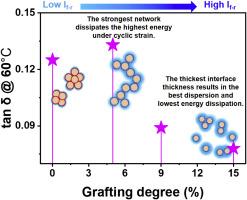Electron tomography as a structural bridge: Linking interfacial engineering to macroscopic viscoelasticity in silica/rubber nanocomposites
IF 9.8
1区 材料科学
Q1 MATERIALS SCIENCE, COMPOSITES
引用次数: 0
Abstract
The interface engineering and dispersion research of nanocomposites have universal applications in flexible electronic materials, intelligent damping materials, and green tire materials. The green tire necessitates rubber composites with low rolling resistance and environmental compatibility, wherein the three-dimensional dispersion and interfacial design of nanofillers play a pivotal role. By integrating electron tomography-based 3D quantification-capable of resolving nanoscale agglomerate compactness, branching, and connectivity-the limitations of conventional 2D microscopy are overcome, revealing a dual-phase dispersion transition modulated by grafting degrees of 3-mercaptopropyl-ethoxy-bis (tridecyl-pentaethoxy-siloxane (Si747), a low-VOC silane coupling agent with shielded alkoxy groups and physical adsorption dual interfacial interactions. At low grafting degrees (0 %–5 %), silica (SiO2) agglomerates exhibited reduced compactness (26 % decrease in Vsilica/Veffect) but increased branching (NBN/NTN from 0.643 to 2.17) and connectivity (Lseg doubled), where energy loss is dominated by cyclic breakdown/reformation of filler networks leading to enhanced Payne effect and elevated tan δ at 60 °C. At higher modification level (grafting degrees 5 %–15 %), ET visualized the disassembly of agglomerates, with a 67 % surge in isolated primary nanoparticles, accompanied by weakened connectivity. Consequently, energy dissipation shifts from filler network breakdown to viscoelastic deformation within the interfacial layer, thereby minimizing overall energy loss. This work challenges conventional paradigms of silica modification and reveals the two-stage mechanism of interfacial modification on dispersion and viscoelasticity from the perspective of 3D dispersion of fillers.

电子断层扫描作为结构桥梁:连接二氧化硅/橡胶纳米复合材料的界面工程和宏观粘弹性
纳米复合材料的界面工程和分散研究在柔性电子材料、智能阻尼材料、绿色轮胎材料等方面具有普遍的应用前景。绿色轮胎需要具有低滚动阻力和环境相容性的橡胶复合材料,其中纳米填料的三维分散和界面设计起着关键作用。通过整合基于电子层析成像的三维定量技术(能够分辨纳米级团聚体的致密性、分支性和连接性),克服了传统二维显微镜的局限性,揭示了由3-巯基丙基-乙氧基-双(三环-五乙氧基-硅氧烷(Si747)的接枝度调节的双相分散转变,Si747是一种低voc硅烷偶联剂,具有屏蔽烷氧基和物理吸附双界面相互作用。在低接枝度(0 ~ 5%)下,二氧化硅(SiO2)团聚体的致密性降低(Vsilica/ effect降低26%),但分支性增加(NBN/NTN从0.643增加到2.17),连合性增加(Lseg增加一倍),其中能量损失主要是填料网络的循环击穿/重组,导致Payne效应增强,在60°C下tan δ升高。在更高的修饰水平(接枝度5% - 15%)下,ET显示团聚体的分解,分离的初级纳米颗粒增加67%,同时连通性减弱。因此,能量耗散从填料网络破裂转移到界面层内的粘弹性变形,从而使总能量损失最小化。本工作挑战了传统的二氧化硅改性范式,从填料的三维分散角度揭示了界面改性对分散和粘弹性的两阶段机制。
本文章由计算机程序翻译,如有差异,请以英文原文为准。
求助全文
约1分钟内获得全文
求助全文
来源期刊

Composites Science and Technology
工程技术-材料科学:复合
CiteScore
16.20
自引率
9.90%
发文量
611
审稿时长
33 days
期刊介绍:
Composites Science and Technology publishes refereed original articles on the fundamental and applied science of engineering composites. The focus of this journal is on polymeric matrix composites with reinforcements/fillers ranging from nano- to macro-scale. CSTE encourages manuscripts reporting unique, innovative contributions to the physics, chemistry, materials science and applied mechanics aspects of advanced composites.
Besides traditional fiber reinforced composites, novel composites with significant potential for engineering applications are encouraged.
 求助内容:
求助内容: 应助结果提醒方式:
应助结果提醒方式:


